6 Manufacturing Insights from Q2 2023 and What They Mean for You
April 27, 2023
As we progress in the second quarter, the manufacturing sector continues to contract as new order levels remain weak and improved supplier deliveries are reducing future production needs. Current railroad traffic and international shipping prices support this slowdown. The weaker demand is reducing input costs, as a result providing inflationary relief, though several commodities are experiencing price rebounds. We may see additional cost relief come from manufacturing-related wages following a deceleration trend in national wages.
1. The manufacturing sector continues to contract further into 2023
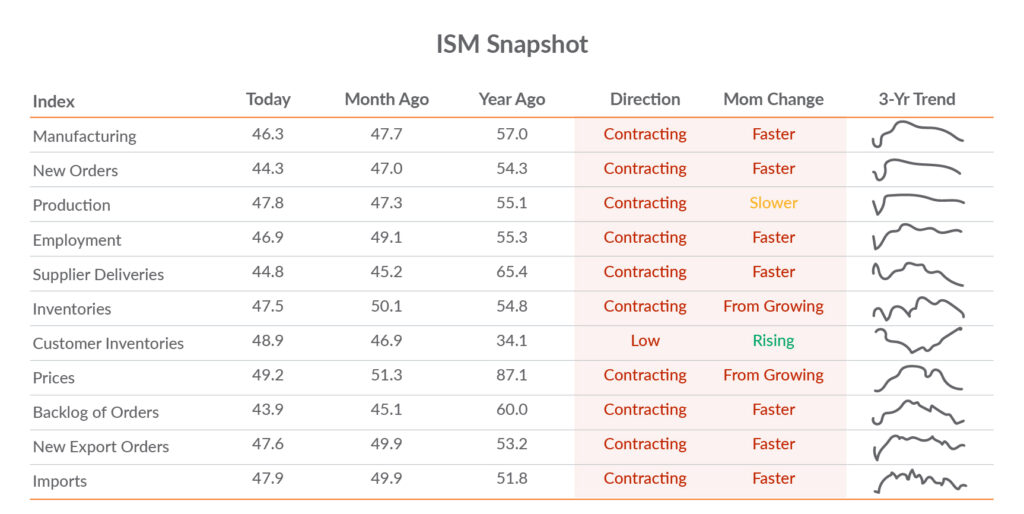
Based on recent surveys of manufacturing companies, the industry continues to contract. Notably, backlogs weaken as new order levels decline, and improved supplier deliveries have reduced future production needs.
What this means for you: Expect demand to remain weak as new orders continue to decline. Consider cost mitigation strategies, such as scaling back production and staffing level changes.
2. Weakening demand helps bring inflationary relief to input costs
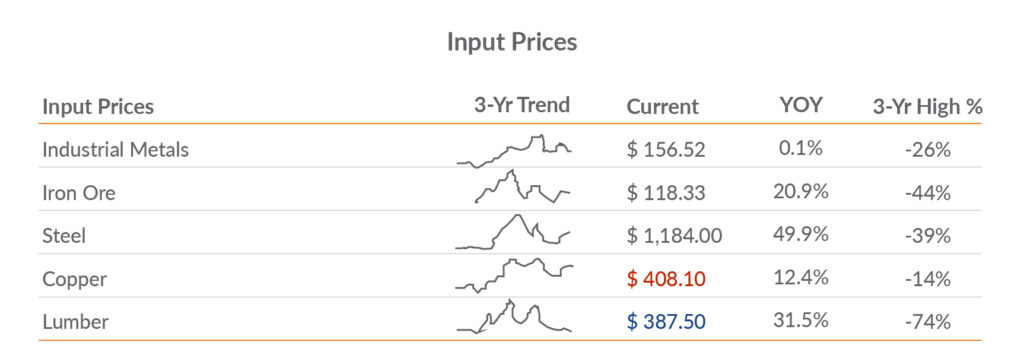
After input prices weathered large increases due to expansionary monetary policies, prices decreased substantially, aided by rising interest rates which help curb inflation. However, pricing is not uniform; inputs, such as copper and steel, have experienced price rebounds recently.
What this means for you: Given the recent price volatility, look to take advantage when prices decline materially by either locking in supply contracts or purchasing forward, which can help with budgeting and your organization’s bottom line.
3. Interest in manufacturing-related jobs is coming off peak interest
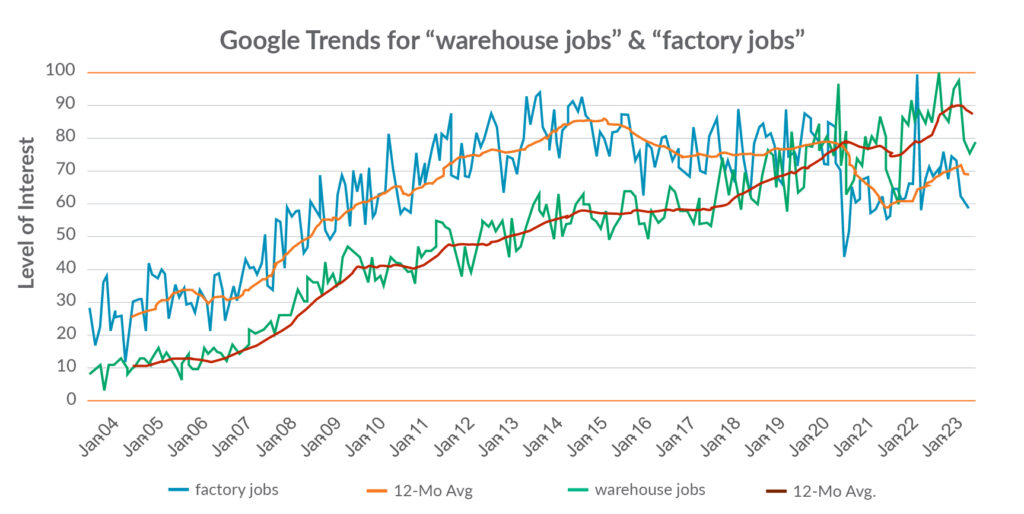
According to Google Trends data, interest in “warehouse jobs” and “factory jobs” continue to trend lower but remain historically high, nearing peak levels. Weaker demand and a slowdown in the manufacturing industry may have more manufacturers delaying hiring as they reduce production, forcing laborers to look for jobs in other industries.
What this means for you: Consider opportunities for flex labor, as manufacturers will be faced with the challenge of managing in a weaker demand environment with the desire to retain quality employees, some of whom were hired within the last few years and may replace employees retiring over the next decade.
4. Wage growth remains elevated but shows signs of relief
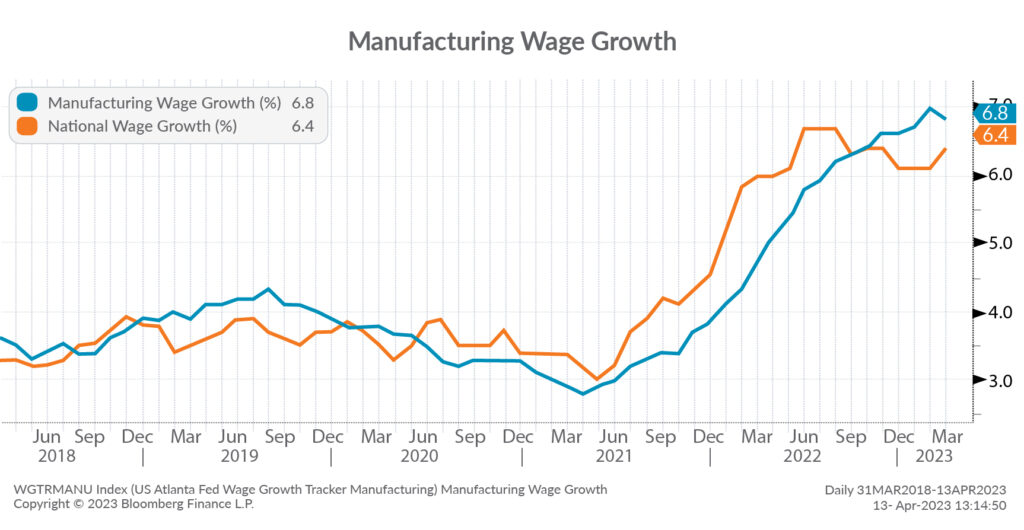
National wage growth, while historically high, appears to have peaked and may begin trending lower. In March, manufacturing wage growth declined slightly after reaching an all-time high in February.
What this means for you: Manufacturing wage growth tends to lag national trends. As a result, expect manufacturing wage growth to decelerate as the economy slows and demand for labor decreases. This should reduce some inflationary pressures.
5. Shipping costs declining and approaching historical levels
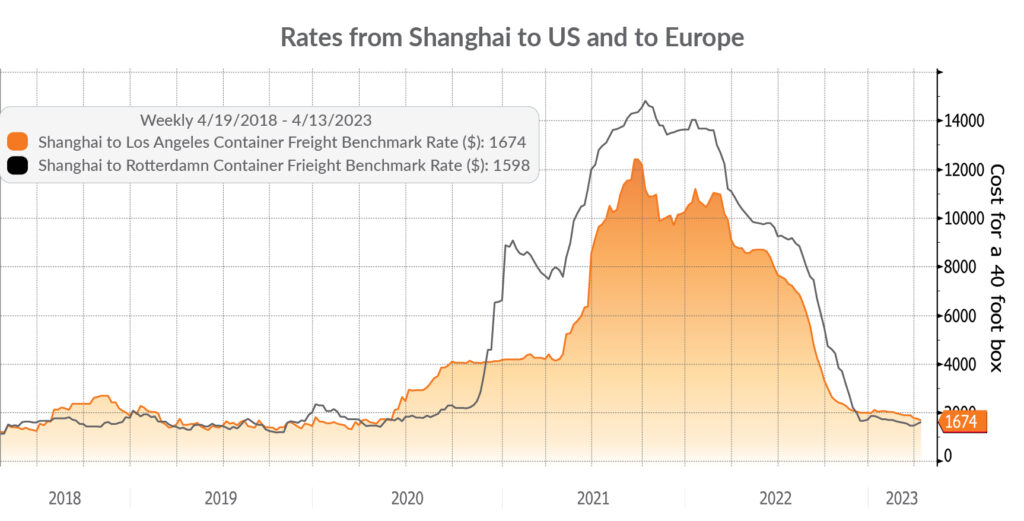
Shipping costs continue to revert to historical, pre-COVID levels. Year-to-date, costs from Shanghai to Los Angeles and Rotterdam ports for 40-foot containers have declined nearly 15%.
What this means for you: The decline in demand for goods has the benefit of reducing demand for containers, helping to lower costs for shipping. Plan for costs to continue to decline as the US economy is expected to slow; however, most of the price decline has already occurred as shipping costs have begun reverting toward more traditional levels.
6. Diminishing railroad traffic continues to suggest weaker demand
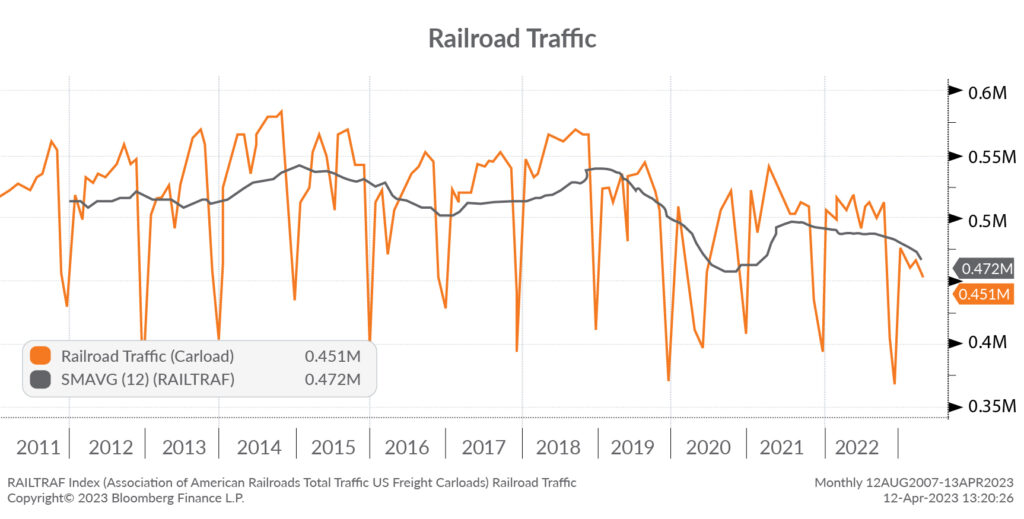
Leading railroad traffic data continues to trend lower and shows signs of demand further weakening in 2023.
What this means for you: With expectations of economic growth to slow in the near-term, railroad traffic may continue to diminish. Pay close attention to railroad traffic and other measures of demand as the barometer for deciding on whether to scale back production or not and reprice your variable expenses as lower demand places downward pressure on prices.
Disclosures
Investment advisory services are offered by Aprio Wealth Management, LLC, a Securities and Exchange Commission Registered Investment Advisor. Opinions expressed are as of the current date (April 24, 2023) and subject to change without notice. Aprio Wealth Management, LLC shall not be responsible for any trading decisions, damages, or other losses resulting from, or related to, the information, data, analyses or opinions contained herein or their use, which do not constitute investment advice, are provided as of the date written, are provided solely for informational purposes and therefore are not an offer to buy or sell a security. This commentary is for informational purposes only and has not been tailored to suit any individual. References to specific securities or investment options should not be considered an offer to purchase or sell that specific investment.
This commentary contains certain forward-looking statements. Forward-looking statements involve known and unknown risks, uncertainties and other factors which may cause the actual results to differ materially and/or substantially from any future results, performance or achievements expressed or implied by those projected in the forward-looking statements for any reason.
No graph, chart, or formula in this presentation can be used in and of itself to determine which securities to buy or sell, when to buy or sell securities, whether to invest using this investment strategy, or whether to engage Aprio Wealth Management, LLC’s investment advisory services.
Investments in securities are subject to investment risk, including possible loss of principal. Prices of securities may fluctuate from time to time and may even become valueless. Any securities mentioned in this commentary are not FDIC-insured, may lose value, and are not guaranteed by a bank or other financial institution. Before making any investment decision, investors should read and consider all the relevant investment product information. Investors should seriously consider if the investment is suitable for them by referencing their own financial position, investment objectives, and risk profile before making any investment decision. There can be no assurance that any financial strategy will be successful.
Securities offered through Purshe Kaplan Sterling Investments. Member FINRA/SIPC. Investment Advisory Services offered through Aprio Wealth Management, LLC, a registered investment advisor. Aprio Wealth Management, LLC and the Aprio Group of Companies are not affiliated with Purshe Kaplan Sterling Investments.
Recent Articles
About the Author
Simeon Wallis
Simeon Wallis, CFA, is a Partner, the Chief Investment Officer of Aprio Wealth Management, and the Director of Aprio Family Office. Each month, Simeon brings you insights from the financial markets in Aprio’s Pulse on the Economy. To discuss these ideas and how they may affect your current investment strategy, schedule a consultation.
Adam Beckerman, CPA, CGMA
Adam Beckerman is Aprio’s Manufacturing and Distribution Leader and Assurance Partner. Adam's team of 30 professionals focus on the manufacturing industry with 20+ years of experience enabling the success of manufacturing start-ups, growth companies and businesses preparing for equity events.
Stay informed with Aprio.
Get industry news and leading insights delivered straight to your inbox.


